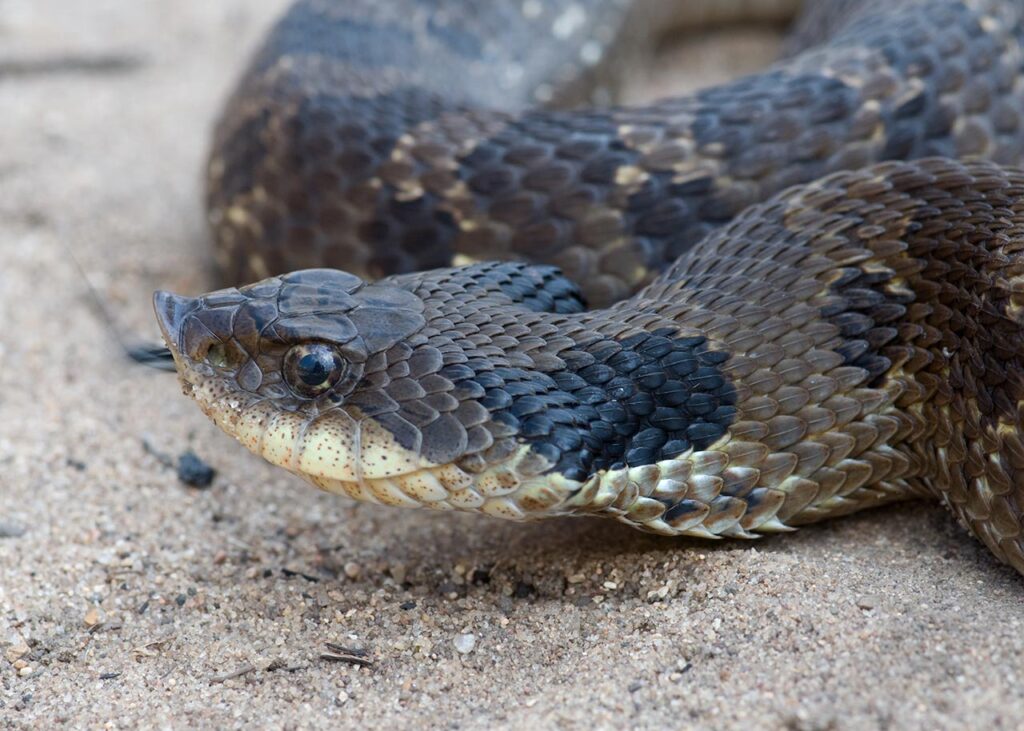Hognose Snake Facts
The hognose snake is not venomous and will not attack unless it feels threatened. In captivity, they can live for up to 11 years. Mating occurs in the spring months, eggs are deposited in the summer, and will hatch in early fall. Usually hognose snakes eat toads and frogs, along with salamanders, small reptiles and their eggs, small mammals like mice, birds, and insects. These snakes are capable of digging, making it easier to attack potential food sources.

Hognose Snake Habitat & Behavior
Hognose snakes can be found skulking about in the daylight hours, particularly in the morning if you live in a warmer environment. Normally, they will bask out in the open, but nest underground, underneath logs, or inside other organic material. You may find elongated droppings around your property, as well as molten snakeskins. It’s difficult to tell if you’ve got these snakes because they move silently, eat their prey whole, and cause very few, if any issues, to the environments in which they live.
Hognose Snake Bites
These reptiles do very little damage to humans, aside from surprising and frightening us. In fact, these snakes are actually essential members of thriving ecosystems. If you’ve got rodent problems, these snakes will most likely help you out, providing natural pest control at no cost to you — aside from the occasional shriek when you stumble across them.
Types of Hognose Snakes
Hognose Snake Identification
One of hognose snake’s most distinguishing characteristics is its wide head with a flattened, upturned snout. These snakes, regardless of species, come in a variety of colors. Their bodies are usually dark and can have splotches that are red, green, orange, brown, black, or tan. They can range from 19 to 45 inches in length. There are three varieties of the hognose snake including the Western hognose snake, the Eastern hognose snake and the Southern hognose snake.
Western Hognose Rattlesnake
The Western hognose snake (Heterodon nasicus) is found in Texas, New Mexico, and in the Plains. They range in length from two to three feet and can be identified by their pig-like, pointed snouts. Dark patterns move down their pale brown to yellowish bodies. Hognose snakes can be identified by their hog-like noses. Another one of the hognose snake’s most distinguishing characteristics is its wide head with a flattened, upturned snout.
Eastern Hognose Snake
The Eastern hognose (Hertrodon platyrhinos) snake is found from Minnesota to New Hampshire, Florida, and in some parts of Texas. They can grow to almost four feet long. They have particularly wide necks and thicker bodies. Their colors vary from yellow or tan to a gray, or reddish color. Some hognose snakes can even be entirely black.
Southern Hognose Snake
The Southern hognose snake (Heterodon simus) is found in North Carolina, Florida, and Mississippi. They are typically tan or gray with very distinct black blotches that run all the way to the tail.
Hognose Snakes in the Garden & Home
These snakes, because of their burrowing and digging tendencies, prefer woodlands with sandy, soft soil, as well as fields, farmland, and coastal environments. If you live in one of these areas, these snakes may slither on by during the day as they hunt for food.
Frequently Asked Questions
Are hognose snakes poisonous?
Unlike vipers or other venomous snakes, hognose snakes can’t carry venom as they don’t have hollow teeth to hold the poison.
They do, however, have toxic saliva glands to use on smaller prey like frogs and toads, but because it can’t be stored in large enough quantities, their bites aren’t harmful to humans.
Hognose snakes are rear-fanged so they only bite when attacking prey. Biting is not a form of defense for hognose snakes, so the only rare case where a human would be bitten is if they smelled like prey.
How do you control a hognose snake infestation?
If you do need these snakes gone, it is possible to deter them. Removing grains, seeds, and other food sources from around your home will deter mice, and thus take away a large part of the snakes’ diet. However, hognose snakes are natural predators to rodents, so you might want to consider keeping some around.
Prevent them from getting into unwanted spaces by sealing any cracks you may find in structures around your property. Keep your grasses and shrubs short to reduce shelter, and remove any clutter or debris from around your yard that may serve as hiding places.
Since these snakes are not venomous, they can be handled with a pair of gardening gloves, placed in a cloth bag, and transplanted to a similar environment where they won’t be a bother to you.
But the best way to keep hognose snakes off of a property is by enlisting the help of a licensed pest or wildlife expert who has the knowledge and skill to remove the pests safely.
What are the benefits of professional snake pest control?
Any type of wildlife nuisance or pest can be risky to remove safely without the proper equipment or experience.
Professional pest control specialists have the technology, educational background, and skill to safely but effectively remove the animal while also protecting everyone on the property.
If you’re struggling with snakes on your property, contact us. Our technicians can remove them and help you regain control of your property and sanity.


